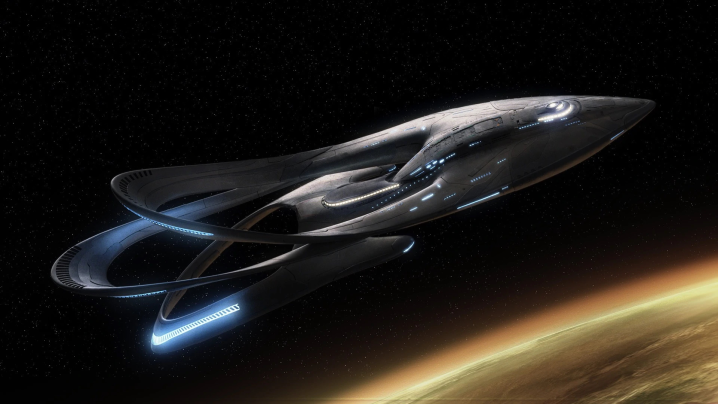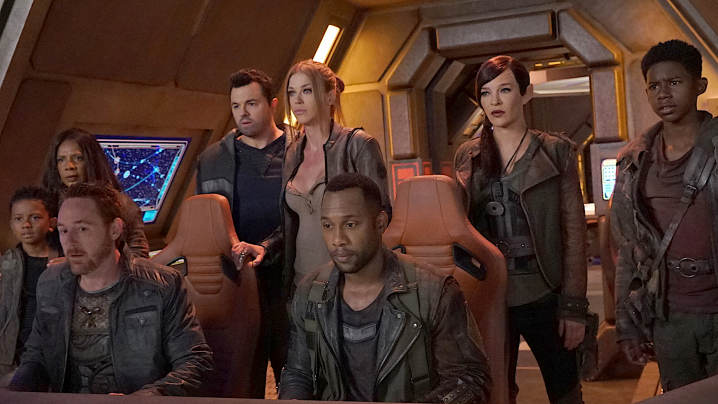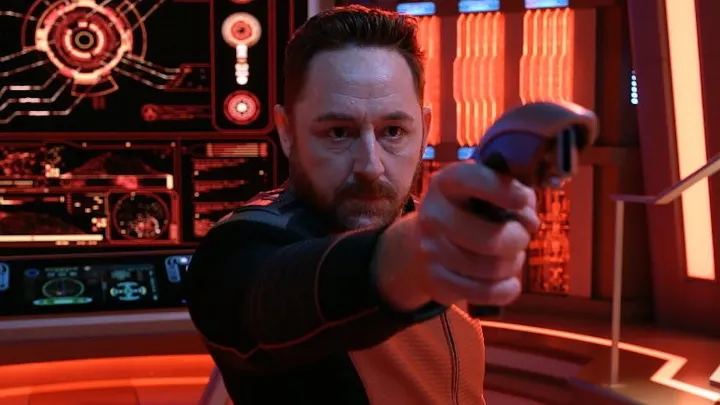Seth MacFarlane’s sci-fi small screen epic, The Orville — now streaming its third season on Hulu as The Orville: New Horizons — is one of the strangest experiments on television. It’s a virtual copy of Star Trek: The Next Generation, a loving homage to that series, and a strong show in its own right. It shouldn’t work, but not only does it work, it has become more intricate and compelling over time (one of many things it has in common with TNG).
There are currently no plans for a fourth season, which is a shame because MacFarlane’s universe is as rich as any sci-fi universe going. As with Star Trek, a wealth of satisfying stories can be spun from this material. The Orville could have easily been a flop, but it’s destined to become a classic in its own right, and one that embodies more of the Star Trek spirit than the officially sanctioned TNG successor Picard ever could.
How The Orville channels The Next Generation

At the universe-building level, The Orville is basically TNG with different names. While this could be an uncharitable description, you only have to watch the show to recognize that MacFarlane and his team — including Brannon Braga, who served as a writer and producer on TNG and other Trek shows — aren’t trying to plagiarize anything. They clearly present The Orville as an alternate universe Star Trek, with characters, species, planets, and technology that would be at home in the original.
Like Trek, The Orville is set centuries in the future during an era when Earth has become part of a Planetary Union similar to the United Federation of Planets. The Union’s primary mission is peaceful exploration and discovery, and one of its flagships is the USS Orville, an Enterprise-like vessel; though, like Starfleet, the Union is also a quasi-military hierarchy with the same naval ranks as Trek: admirals, captains, commanders, lieutenants, and so on.

The Union maintains tense alliances with various alien species, including the Krill and the Moclans, both of which resemble the Klingons from Star Trek. The main villains, meanwhile, are the Kaylons, an android collective dedicated to wiping out biological lifeforms. With their merciless mission and advanced technology, they resemble The Next Generation’s famous Borg.
Perhaps the main difference between the two fictional worlds is that the Enterprise and other Trek ships use transporters to “beam” people to and from their destinations, whereas Union ships must ferry officers and crew around via shuttlecraft. Though given the show’s high-quality special effects, it makes sense to include dazzling shots of shuttles whizzing onto the surface of planets and docking in gleaming bays. They also feature in some nifty action sequences as well — something The Orville does better than TNG, not surprisingly, given 30 years of VFX advances.
A special found family dynamic

As with the similarities between the fictional worlds, the main characters in The Orville mirror their Next Generation counterparts. TNG‘s famous crew included Captain Jean-Luc Picard (Patrick Stewart); first officer, Will Riker (Jonathan Frakes); the android second officer, Data (Brent Spiner); the Klingon security chief, Worf (Michael Dorn); Chief Medical Officer, Dr. Beverly Crusher (Gates McFadden); the ship’s counselor, Deanna Troi (Marina Sirtis); and Chief Engineer Geordi La Forge (LeVar Burton).
The Orville presents almost exact replicas of some of these characters. McFarland himself plays Captain Ed Mercer. His first officer (and ex-wife) is Commander Kelly Grayson (Adrianne Palicki). The ship’s Chief Medical Officer is Dr. Claire Finn (Penny Johnson Jerald). The Kaylon Science Officer, Isaac (Mark Jackson), the Moclan Second Officer, Bortus (Peter Macon), and the Chief Engineer John LaMarr (J. Lee) are so similar to TNG‘s Data, Worf, and La Forge, respectively, it’s almost funny. And perhaps these characters would feel more like knockoffs if they weren’t so well developed and performed. Jackson is especially memorable as an entity that is just as particular and contradictory as Data — no small feat, given he’s walking in the robot steps of Brent Spiner’s classic creation.
MacFarlane has long been a fan of TNG and its characters. The main cast even lent their voices to an episode of Family Guy (if anyone somehow doesn’t know, MacFarlane is that show’s creator as well as one of its principal voice actors). In general, MacFarlane makes no secret that he is both a television lover and a walking catalog of TV knowledge. His gift for simultaneously mimicking and satirizing TV tropes is the key to Family Guy‘s success, along with his innate understanding of how “family” dynamics work on TV. He understands that some of the most beloved shows — Cheers, M*A*S*H, The Mary Tyler Moore Show, and the original Star Trek, among them –– are about found families, people thrown together through work or circumstance who come to care about each other deeply, and for whom the audience comes to care deeply as well.

Star Trek: The Next Generation is one of the great found family shows. Its main characters became devoted to each other over seven seasons of having their relationships forged in fire. On Picard, the belated sequel to TNG (the third and final season is currently in production), the older Picard proclaims his love for the deceased Data often, drawing on viewers’ tender feelings and nostalgia for their relationship.
Unfortunately, Picard doesn’t create relationships of similar depth within its own drama. It tries to use the “gathering the team formula” typical of heist movies to create a found family crew, but the result is an uneasy dynamic. Aside from the still-great Patrick Stewart, neither Picard‘s characters nor its actors contribute anything memorable. At the show’s worst, some of the supporting actors — young and too attractive and spouting quippy dialogue that sounds way too contemporary — feel like they beamed over from a CBS procedural.
The Orville channels the best TNG stories

The Orville, on the other hand, perfects the found family dynamic. As with TNG, the characters and relationships are the keys to the show’s enormous emotional appeal. The big advantage of creating the show in today’s viewing environment is that MacFarlane can pay careful attention to the quality of the stories. TNG was famously uneven, largely because of the pressure to come up with 26-hour-long episodes a year for seven straight years (22 in season 2, due to the Writers Guild strike). It’s not easy to write compelling drama with huge stakes at heightened levels of philosophical, intellectual, and human interest, while also trying to continually expand an enormous story world and do it all with expensive and elaborate special effects and production design.
But when the showrunners nailed it, they really nailed it. The great episodes of TNG — including The Inner Light, Cause and Effect, The Measure of a Man, The Best of Both Worlds, and All Good Things — remain among TV’s great episodes. The advantage of The Orville is that in creating only 10 to 14 episodes per season — and with a three-year hiatus between seasons 2 and 3 — the writers could pay greater attention to quality. In essence, almost every episode of The Orville (yes, there are a few weaker ones) feels like a good to great episode of TNG.

One of the ways that the show honors TNG storytelling in general, and the found family dynamic in particular, is through the approach of highlighting different supporting characters in each episode. You have to give MacFarlane credit for checking his ego here. He never tries to make Mercer the alpha male hero, and neither does he stand back at some comic remove, making fun of everything (although the early episodes were funnier, sometimes distractingly so, as the show was trying to find its tone). Instead, he fully commits to this material and the result is that The Orville has become very involving, even moving, over the course of its run.
One of the best season 3 episodes, Midnight Blue, exemplifies the approach. Written by Brannon Braga & André Bormanis, Midnight Blue furthers the saga of Topa (Imani Pullum), a young Moclan born of two fathers, Bortus and Klyden (Chad L. Coleman), who undergoes gender reassignment surgery to become female against Klyden’s wishes. When Topa later becomes imperiled by warring factions who want to use her for political ends, the crew risks everything to save her, concluding with a sequence of family reunion that will have you sobbing.

Dolly Parton also features in the episode as a feminist icon from the past. She gets a beautiful scene in which the show uses her music to underscore a stirring sacrifice by one of the characters. By all rights, the Parton stuff should play more like one of the famous interstitial scenes from Family Guy that delivers a joke but isn’t part of the narrative proper. Instead, we see that her music truly belongs in the stars.
All of this extends Star Trek’s progressive legacy. It’s a little astounding, given the crass misogyny of Family Guy (I know it’s supposed to be a put-on, but still), how progressive The Orville tries to be, especially in the way it insists on tolerance and equality around issues of gender, sexuality, and race. Star Trek has always been avowedly progressive. But, as fans know, different iterations of Trek have been trapped within the constraints of their cultural eras — which is why, for example, it took decades for the franchise to start prominently featuring LGBTQ+ characters. Although far from perfect, The Orville tries to use its platform to show how humans have evolved to become enlightened in ways that resonate meaningfully for groups and people struggling today.
It wrestles with philosophical conundrums

One final reason for the greatness of The Next Generation was that it dramatized enormous philosophical issues about the befuddling contradictions of human identity, the mysterious nature of time and memory, and the agony of negotiating impossible moral quandaries. Star Trek in general often uses time travel as a, ahem, vehicle to explore such ideas, and TNG also employed its famous “temporal shifts.”
In The Inner Light, one of the most mind-blowing episodes of television ever produced, Picard gets knocked out by an alien presence and wakes up to find out that he’s been deserted on another planet. He gives up hope of being rescued and lives the rest of his life in his new home. At the episode’s conclusion, he wakes aboard the Enterprise to find out he’s only been unconscious for about 25 minutes, yet now lives with this entire alternate reality inside him. It’s a profound way of dramatizing how many paths our lives can take, as well as the humbling reality that, on a cosmic scale, none of us lives more than an instant.

The Orville‘s season 3 time-travel episode, Twice in a Lifetime, written by MacFarlane, presents its own version of a knotty time travel problem when helmsman Gordon Molloy (Scott Grimes) gets trapped on Earth circa 2025. The Orville’s crew figures out a way to go back to retrieve him, but mistimes their jump into the past and lands about 10 years after Molloy has established a new life with a wife and kids to whom he is now devoted.
Molloy strongly resists returning to the Orville and his old life, but he’s violating strict rules about screwing with the past that could alter the future. How do you make the choice to give up your family for the greater good? And if you could return and blank the memory of your alternate life, would that experience somehow linger within you? And would you want it to linger or would that be too painful? This is just one of the many gripping scenarios that make The Orville such a worthy descendant of Star Trek: The Next Generation, and one of the most thoughtful shows on television.
Editors' Recommendations
- How do I get into Star Trek? A guide to how to watch the beloved sci-fi franchise
- New Star Trek videos pave the way for Strange New Worlds
- Strange New World’s latest trailer goes old-school Star Trek




